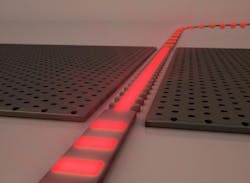In 2015, researchers at the Harvard John A. Paulson School of Engineering and Applied Sciences (SEAS) developed the first on-chip metamaterial with a refractive index of zero, meaning that the phase of light could be stretched infinitely long. The metamaterial represented a new method to manipulate light and was an important step forward for photonic integrated circuits (PICs), which use light rather than electrons to perform a wide variety of functions. Now, SEAS researchers have pushed that technology further by developing a zero-index waveguide compatible with current silicon photonic technologies. In doing so, the team observed a physical phenomenon that is usually unobservable: a standing wave of light.
RELATED ARTICLE: Erasable gratings facilitate automated PIC testing
The research is published in ACS Photonics and the Harvard Office of Technology Development has filed a patent application and is exploring commercialization opportunities.
When the refractive index of a medium is reduced to zero, the light no longer behaves as a moving wave, traveling through space in a series of crests and troughs, otherwise known as phases. Instead, the wave is stretched infinitely long, creating a constant phase. The phase oscillates only as a variable of time, not space.
This is exciting for integrated photonics because most optical devices use interactions between two or more waves, which need to propagate in sync as they move through the circuit. If the wavelength is infinitely long, matching the phase of the wavelengths of light isn’t an issue, since the optical fields are the same everywhere.
But after the initial 2015 breakthrough, the research team ran into a catch-22. Because the team used prisms to test whether light on the chip was indeed infinitely stretched, all of the devices were built in the shape of a prism. But prisms aren’t particularly useful shapes for integrated circuits. The team wanted to develop a device that could plug directly into existing photonic circuits and for that, the most useful shape is a straight wire or waveguide.
The researchers--led by Eric Mazur, the Balkanski Professor of Physics--built a waveguide but, without the help of a prism, had no easy way to prove if it had a refractive index of zero. Then, postdoctoral fellows Orad Reshef and Philip Camayd-Muñoz had an idea; they "pinned-down" the light by shining beams in opposite directions through the device to create a standing wave. The individual waves were still oscillating quickly but they were oscillating at the same frequency in opposite directions, meaning at certain points they canceled each other out and other points they added together, creating an all light or all dark pattern. And, because of the zero-index material, the team was able to stretch the wavelength large enough to see.
This may be the first time a standing wave with infinitely-long wavelengths has ever been seen.
"This adds an important tool to the silicon photonics toolbox," said Camayd-Muñoz. "There's exotic physics in the zero-index regime, and now we're bringing that to integrated photonics. That's an important step, because it means we can plug directly into conventional optical devices, and find real uses for zero-index phenomena. In the future, quantum computers may be based on networks of excited atoms that communicate via photons. The interaction range of the atoms is roughly equal to the wavelength of light. By making the wavelength large, we can enable long-range interactions to scale up quantum devices."
SOURCE: Harvard SEAS; https://www.seas.harvard.edu/news/2017/10/zero-index-waveguide

Gail Overton | Senior Editor (2004-2020)
Gail has more than 30 years of engineering, marketing, product management, and editorial experience in the photonics and optical communications industry. Before joining the staff at Laser Focus World in 2004, she held many product management and product marketing roles in the fiber-optics industry, most notably at Hughes (El Segundo, CA), GTE Labs (Waltham, MA), Corning (Corning, NY), Photon Kinetics (Beaverton, OR), and Newport Corporation (Irvine, CA). During her marketing career, Gail published articles in WDM Solutions and Sensors magazine and traveled internationally to conduct product and sales training. Gail received her BS degree in physics, with an emphasis in optics, from San Diego State University in San Diego, CA in May 1986.
